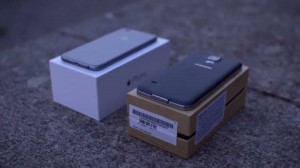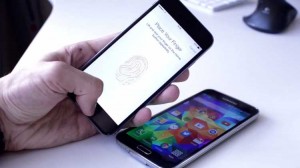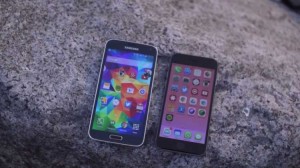Samsung’s smaller flagship, the Galaxy S5, has stirred up water this year being one of the best Android phones on the market for a while. The iPhone 6 is Apple’s latest flagship that means to continue the tradition of Apple releasing premium smartphones as it did before with the iPhone 5 and iPhone 5S. The Galaxy S5 and iPhone 6 are considered the two most popular smartphones of the year, so it wouldn’t be surprising if one had encountered difficulties when trying to decide between the two.
While the Galaxy S5 is Samsung’s current flagship of the year, the Galaxy Note 4 has stolen some of its spotlight with its astounding screen and great battery life. Its brother, the Galaxy Note Edge has also gathered a crowd of fans thanks to the hanging edge display on the phone which makes it look funny, but be functional. The Galaxy Alpha is also a recent Samsung release aimed at those of you who prefer metal phones and premium designs. The Galaxy Alpha came as a response to the Galaxy S5, after many users complained about the cheap design and band-aid back panel made out of perforated polycarbonate.
The Galaxy Alpha was less successful than its cousin, the Galaxy S5, because it came as a mid-range smartphone with a pretty hefty price. When it comes to bang for buck, the Galaxy Alpha has a low ratio. Nonetheless, the Galaxy Alpha was the first step on the part of Samsung in the direction of premium designs. Consequently, the phone inspired a whole new line of smartphones, the Galaxy A3, A5 and A7, which come with metal unibodies and pretty good specs. While these phones are certainly not the topic of this comparison, they are worth mentioning since many consider them a direct consequence of the criticism Samsung got about the Galaxy S5 flagship.
The iPhone 6 from Apple wasn’t as criticized as the Galaxy S5 or its larger brother, the iPhone 6 Plus, for that matter. The iPhone 6 is actually the successor of the iPhone 5S and marks a cornerstone in Apple’s development and design. With the iPhone 6, Apple attempted to “catch up” to Android smartphones which are considered to have more features and functions at a lower price. While Apple didn’t make a cheap iPhone 6 or cheap iPhone 6 Plus, they did manage to improve the software and hardware of their new flagship.

The iPhone 6 and the Galaxy S5 and their respective boxes.
Compared to its predecessor, the iPhone 6 coupled with Apple’s new iOS 8 actually brings the user experience closer to an Android Jelly Bean or earlier experience. Not to say that Android is better than the iOS, but it seems like iOS users have been longing for the virtually free experience of Android smartphone users and Apple has noticed it too. With the iPhone 6 and iOS 8, Apple opened up a bit about its ecosystem and decided to add some features that were specific to Android until now. Third-party keyboards, NFC, widgets, actionable notifications and Continuity are just the tip of the ice-berg. You can refer to an in-depth comparison between Android 5.0 Lollipop and iOS 8, if you like.
In any case, the iPhone 6 marks a new era for Apple. The iPhone 6 design hasn’t changed much, the flagship has become thinner and larger, sporting a bigger display. The iPhone 6 responds to the new phablet trend in its own way, with a 4.7 inch display. Its big brother, the iPhone 6 Plus is actually designed to cater to phablet users who had no place in the Apple ecosystem until now. With the iPhone 6 Plus, Apple is trying to lure former Android or Windows Phone users into its ecosystem. Since the iPhone 6 Plus has a big 5.5 inch display, it can directly compete with devices like the Galaxy Note 4, Huawei Ascend Mate 7, Xiaomi Mi4, Meizu MX4 Pro, HTC One M8, Samsung Galaxy Note 3, Galaxy Core and the list continues. The iPhone 6, on the other hand, aims to give Apple fans the new flagship they have been waiting for.
The Samsung Galaxy S5 was launched in the beginning of Summer, as usual for Samsung, so it is an older release than the iPhone 6. Nonetheless, the Galaxy S5 has all the flagship qualities one might be searching for. The iPhone 6 was launched in September, alongside the iPhone 6 Plus, HealthKit, Apple Pay, HomeKit and the Apple Watch. To be fair, the Apple Watch was not launched when the new iPhones were, it was merely teased in connection with the phones and the new HomeKit and HealthKit platform Apple had been working on. Even though the two flagships were launched months apart, there still is fierce competition between them. Just look at the best selling smartphones at Amazon and Best Buy. The iPhone 6 is in the lead at the moment, but the Galaxy S5 was the first on the list until last month.

Fingerprint sensors
While the iPhone 6 came with the newest software from Apple, iOS 8, out of the box and subsequently received the iOS 8.1 update to fix the issues the first release had, the Galaxy S5 isn’t as lucky. The Galaxy S5 comes with Android 4.4 KitKat out of the box, but is set for an Android 5.0 Lollipop update later this month, if rumors are true. The Galaxy S5 Android 5.0 Lollipop update should bring users a revamped Material Design, notifications system and a few new functions and quirks.
The iPhone 6 design hasn’t changed too much since its predecessor, but it does have a few extra things to brag about. The iPhone 6 design consists of an aluminium unibody with chamfered edges and a light, thin build. Even though the design looks pretty good, we would have liked to see thinner bezels on the phone, and we would have felt better without those strips running on the back of the phone. Nonetheless, the iPhone 6 is nothing short of premium and feels great in the hand, and in the pocket. The sturdy aluminium unibody promises a pretty long life and durability for the device, which is what most people are looking for nowadays.
The Galaxy S5 design, as I’ve mentioned, is far from perfect, but it’s not big enough of a flaw to make the phone repulsive. The Galaxy S5 design has a polycarbonate body with a perforated back panel and faux chrome finish on the frame. Even though the flagship looks tacky, it still is a durable, well-built smartphone that can be handled easily. Samsung would have done a better job on the Galaxy S5 if they had realized that metal was something more and more people were craving for. If the design was similar to what they did with the Galaxy Alpha and Galaxy Note 4, the Galaxy S5 would have become the best selling and most popular smartphone in no time. Alas, Samsung took its sweet time to listen to customers.
It’s not all bad when it comes to the Galaxy S5 design, though. The polycabronate body allows for IP67 certification, which means the phone is dust- and waterproof, something we can’t say about the iPhone 6. While the iPhone 6 will certainly suffer if you accidentally dropped it in the toilet, the Galaxy S5 will just shrug it off and be on its way. IP certification is one of the best features a manufacturer can add to the phone cause it adds to the durability and quality of the handset, and attracts customers with more active lifestyles as well.
The issue of pricing should be next thing we address, since there are few people out there who go shopping without planning a budget beforehand. In consequence, the Galaxy S5 price is around $600 at the moment, but with Black Friday and the holidays coming up, you are sure to get a great deal on the Galaxy S5. The iPhone 6 price is on the hefty side, being $650 for the 16 GB storage version, $750 for the 64 GB version and $850 for the 128 GB version. Charging $100 just for a memory upgrade instead of building in a microSD card slot says a lot about Apple. The Galaxy S5 has a microSD card slot that can handle up to 128 GB of extra storage, which beats Apple’s offering at the moment. At the same time, iPhone 6 Black Friday deals are sure to pop up soon, so if you’re set on Apple’s flagship, keep a look out for Amazon and Best Buy deals.
The Galaxy S5 has a 5.1 inch 1080*1920 resolution display, while the iPhone 6 sports a 4.7 inch 750*1334 resolution screen. While Retina display tends to impress, we did like the Galaxy S5 display more, although it did encounter some color reproduction issues here and there. Otherwise, the Super AMOLED Galaxy S5 screen is bright, crisp and vivid and gets pretty good outdoor visibility. The iPhone 6 display isn’t bad, but we think that Apple could have done way better than that. With that in mind, pixel density on the iPhone 6 is 326 ppi, while on the Galaxy S5 it’s 432 ppi.
The Galaxy S5 and iPhone 6 both have fingerprint sensors built into their home buttons, but the TouchID on Apple’s device tends to work better. TouchID is faster and more accurate than the fingerprint sensor on the Galaxy S5. Apple Pay is one of the services Touch ID will be useful for, and marks one of the new improvements Apple decided to incorporate in the bundled iPhone 6 and iOS 8 package. Other features like HealthKit and HomeKit would also suit those of you who have the budget for full home automation and various fitness tracking gadgets. If you’re the one to spend a lot of time shopping online or using various secure online services, Touch ID and Apple Pay will surely come in handy. Apple Pay will also help you out as a regular shopper, since it entails use of your phone instead of a card at a cash register, which is pretty neat, in my opinion.
The Galaxy S5 doesn’t have an Apple Pay service to boast with, but it does have an improved TouchWiz UI, as well as a pretty impressive S Health app which does the same thing HealthKit does, save for the Mayo Clinic integration. And the absence of Apple Pay and an accurate fingerprint sensor is made even with the IP67 certification. The Galaxy S5 also has the added advantage of a lower price, which can be a deal-maker for many smartphone enthusiasts out there. The bang for buck ratio for the Galaxy S5 is also a bit better, as you will come to see by the time you reach the end of this comparison, hopefully.
The Galaxy S5 runs on the Snapdragon 801 CPU with Adreno 330 GPU, backed by 2 GB RAM and either 16 or 32 GB internal storage. The iPhone 6 runs on Apple’s own A8 chipset, with the M8 coprocessor on board, backed by 1 GB and the aforementioned 16, 64 and 128 GB storage versions. We have no complaints regarding either flagship when it comes to performance. Both the iPhone 6 and Galaxy S5 can get through intensive use with ease and perform anything you throw at it with ease. While iOS 8 did have its issues when it first came out, subsequent updates have resolved most of them. If you are set on getting a phone that will run anything you throw at it smoothly and without issue, both of these will do just fine for your preferences. I would rather advise to choose based on OS, focusing on whether you like iOS 8 or Android KitKat, although KitKat will soon be replaced with Android 5.0 Lollipop.

Display and size
The iPhone 6 camera is an 8 MP iSight on the rear with great manual customization. Optical image stabilization has only been included on the iPhone 6 Plus and we think Apple could have included it in the smaller version of the flagship, too. Nonetheless, the iPhone 6 camera takes great shots, even in low-light conditions and has an easy user interface to go with it. The iPhone 6 front camera is a standard 1.2 MP FaceTime camera, which makes for pretty good selfies and videos compared to other phones. The Galaxy S5 camera on the other hand is a 16 MP sensor on the rear and 2 MP on the front. The Galaxy S5 camera does have issues when it comes to low-light conditions, but it produces higher quality images than the iPhone 6 when the lighting is optimal. I would call this round a tie.
The iPhone 6 battery is a 1810 mAH one, with an acceptable battery life of about a day and a half with moderate use. Apple could have put a bigger batter into the phone and made it a bit thicker, which wouldn’t have bothered most of the users. Alas, the company sacrificed the battery size in favor of a slim and light design. The Galaxy S5 battery is much larger, measuring 2800 mAH. Even so, the battery life isn’t much more impressive than on the iPhone 6, since it has a larger screen with more pixels to power. AMOLED screens tend to consume more than the iPhone 6 Retina display, so the battery life in the end is pretty much the same. If you want maximum battery life, though, you should check out the Galaxy Note 4 or Sony Xperia Z3, which have scored impressively on battery life tests with two days of moderate use.
As you can see, the Galaxy S5 and the iPhone 6 size up pretty nicely next to each other and each has its own quirks and drawbacks. While the iPhone 6 is a bit on the expensive side, it does have a premium build, new software, great camera and a pretty accurate fingerprint sensor. The Galaxy S5 is the cheaper version if you want a flagship, and has great performance reports, takes great photos if the lighting is optimal and has a pretty good battery life. In spite of that, the Galaxy S5 design is the biggest flaw of the phone, but our guess is that one can always opt for a stylish case. Which flagship do you think is better? Which would you choose if the iPhone 6 and Galaxy S5 were offered up for free?
